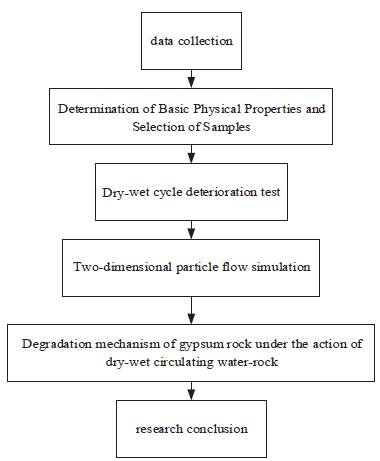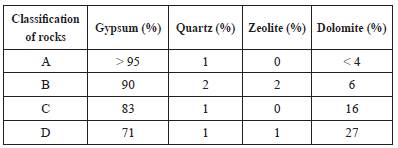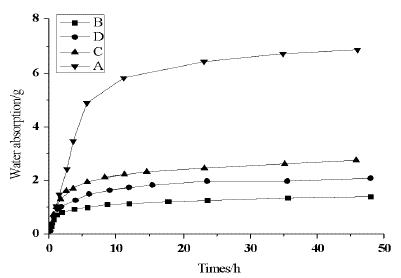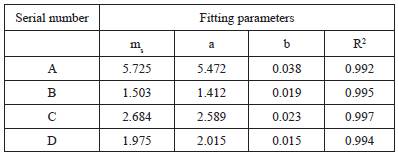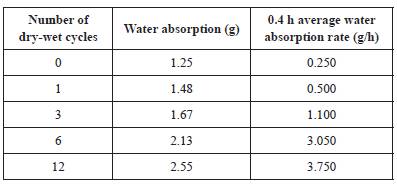Introduction
From the deep part of the earth to the surface of the earth, water-rock interaction is ubiquitous, especially the wet-dry cycle (Jian & Niu, 2016). It is the most closely related to human activities, and is also one of the most common water-rock interactions. For example, the precipitation and evaporation of rainwater and the rise and fall of reservoir water level are all the inducements of dry-wet circulation. The deterioration of rock mass caused by dry-wet cycling is equivalent to a kind of "fatigue effect", and this deterioration is usually stronger than that of long-term immersion (Yao et al., 2015), which has an important impact on the stability and safety of rock mass engineering (Jiang & Shao, 2014). Therefore, it is of great engineering significance to study the deterioration characteristics of mechanical properties of rock mass and rock mass under dry-wet cycling. In recent years, scholars at home and abroad have carried out extensive experimental studies on the changing law of rock mechanical properties under dry-wet cycling, and obtained many research results (Li et al., 2015).
Numerical simulation is one of the important means to study the mechanical characteristics of rock (Gaylarde et al., 2017). In recent years, the discrete element method (DEM) has been widely used in the numerical simulation of rock mechanical properties because it does not involve complex macro-constitutive models and can analyze the numerical simulation results from macro and micro levels (Ion et al., 2016). Particle flow code (PFC) is a kind of DEM, which constructs rock materials into aggregates of particles and simulates the macro-mechanical properties of rock materials through the interaction of particles (Grandclerc et al., 2016). PFC has been widely used in rock fracture analysis. In PFC, the macro mechanical properties of rock cannot be given directly, but should be matched by setting the geometric parameters and contact properties of particles and choosing reasonable meso-parameters. Trial-and-error method is the most commonly used method for calibrating meso-parameters at present (Sijakova-Ivanova et al., 2014). By comparing the macro-mechanical parameters of rock and numerical simulation results, the meso-parameters are adjusted continuously to achieve the similarity between them. If the relationship between macro and micro parameters is not understood and the micro parameters are randomly adjusted, it may lead to a large number of numerical experiments and increase the difficulty of modeling (De Weerdt & Justnes, 2015).
Based on the above background, in this experiment, gypsum rock is taken as the research object in order to study the deterioration degree of the physical and mechanical properties of gypsum rock caused by wet-dry cycling. Combined with laboratory tests, theoretical analysis and numerical simulation of particle flow, water absorption and water loss tests are carried out on gypsum rocks under different drying and wetting cycles. Water absorption and water loss characteristics, pore characteristics and mechanical characteristics of gypsum rocks are obtained. The deterioration effect of gypsum rock under dry-wet cycling is discussed in detail, which provides a new theoretical basis for future research.
Method
Research content and technical route
In this study, through data acquisition and field investigation, combined with laboratory experiments and theoretical analysis, the basic physical characteristics of gypsum rocks are described. The main components, water absorption, water loss, fracture inclination and uniaxial compressive strength of gypsum rocks are studied, and the preparation for the subsequent dry-wet cycle experiments is made in advance. The effect of dry-wet cycling on the deterioration characteristics of gypsum rocks has been studied under the PFC. Gypsum rocks are subjected to dry-wet cyclic deterioration tests, and gypsum rocks with different cycles are subjected to water absorption and loss tests as well as pore characteristics experiments. Then, the effects of dry-wet cycle on water absorption loss, pore structure and mechanical properties of gypsum are discussed. On this basis, the deterioration mechanism of gypsum is also analyzed. Finally, the particle flow law of gypsum in different drying and wetting cycles was determined under the background of PFC. The relationship between crack inclination and uniaxial compressive strength under different drying and wetting cycles is studied through bonding clearance and meso-parameters. The mechanism of meso-deterioration of gypsum rock under drying and wetting cycles is further discussed. The technical route of this research is shown in the following figure.
Main components of gypsum minerals
Gypsum samples are collected from the field. In the laboratory, its components are studied experimentally. The samples are analyzed by X-ray images and the diffraction patterns are obtained. Then, according to the diffraction pattern, the main components and their respective contents of gypsum rocks are calculated. According to the different contents of main minerals, the samples of experimental rock blocks are divided into four groups, numbered A, B, C and D in turn. The final results are shown in the table below. According to the table, gypsum, quartz, zeolite and dolomite are the main components of gypsum rocks. Gypsum occupies the most components in gypsum rocks, so the various characteristics of gypsum greatly affect the characteristics of gypsum rocks.
Characteristics of water absorption curve of gypsum rock
In order to obtain representative standard specimens from four groups of specimens, water absorption tests are carried out at room temperature of 16°C ± 2°C. After 10 days of continuous water absorption, the water absorption of each sample remains basically stable. The following figure shows the variation curve of water absorption of gypsum rocks with water absorption time.
During the 10-day water absorption process, the accumulative water absorption of group A rock sample is the largest, reaching 5.78g. Secondly, the accumulative water uptake is 2.54g and 1.98g in group C and D, respectively. The cumulative water absorption of group B is the smallest, which is 1.46g. The cumulative water absorption of each group of samples is mainly completed in the early stage of water absorption. One day after water absorption, the accumulative water absorption of group A is 61.3%, and the accumulative water absorption of other groups is more than 36%. Four days after water absorption, the accumulative water absorption of group A is over 92%, and the accumulative water absorption of other groups is over 82%. There are also obvious differences in the water absorption rate of each stage, and the water absorption rate decreases gradually with the increase of time.
With the increase of water absorption time, the water absorption of gypsum rocks reaches a certain degree of saturation, and the water absorption decreases slowly, gradually tends to zero. Then, the water absorption characteristic curves of each group of gypsum rocks are fitted by negative exponential function. The general fitting expressions are as follows:
In the above formula, t represents the time when gypsum rock absorbs water. m s indicates the saturation of gypsum rock when it is saturated by water absorption. a and b represent the itting parameters.
The following igure shows the itting parameters of water absorption curve of gypsum rock. From the following table, it can be seen that the fitting effect is good and the fitting correlation coefficient is above 0.99.
Effect of porosity of gypsum rocks on water absorption characteristics
The water absorption characteristics of gypsum rocks are mainly influenced by porosity and pore structure, and the size, shape and connectivity of pore will change the water absorption characteristics of gypsum rocks. In order to obtain more accurate results, four test samples with different porosity are selected to study the effect of porosity on water absorption characteristics. Water absorption experiments are carried out under the same experimental conditions, so water absorption curves and parameters are obtained. The experimental results show that the higher the porosity of the sample is, the higher the water absorption is and the higher the water absorption rate is. It is found that intergranular pore, dissolution pore and dissolution pore are the main pore types of gypsum rocks. Intergranular pore is the main pore type. Intergranular pore refers to the pore between gypsum crystals. Because of the close contact between crystals, the intergranular pore becomes limited and the diameter becomes smaller, but they are the main channel of water absorption. The dissolution pore is produced by the contact between gypsum rock and groundwater. The dissolution pore of the dissolution pore is small and the regularity is not strong, and the shape and size of the dissolution pore are also different. If the connectivity is good, the dissolution pore can form a pore network together with the intergranular pore. In addition, there are some independent dissolution holes in gypsum crystal, which is caused by incomplete dissolution of gypsum crystal. The dissolution pore is relatively small in volume and low in connectivity, and has little water absorption to rocks.
Particle flow model of gypsum rocks
When establishing the particle flow model of gypsum rock, because the macro-mechanical parameters of the model are affected by the number and size of gypsum rock particles, it is necessary to take into account the effect of RES (resolution) on the macro-mechanical parameters at the minimum scale of the model. Some studies believe that the number and size of gypsum particles have the least influence on the particle flow model of gypsum rocks when RES > 10, while others believe that the number and size of gypsum particles have the least influence on the particle flow model of gypsum rocks when RES > 20. Therefore, in this experiment, the simulation scale and calculation speed are considered comprehensively, and the particle flow model of gypsum rock is analyzed.
The calculation formula of RES is as follows:
In the formula above, Rm¡n represents the diameter of the smallest particle. In this study, Rm¡n = 0.4, and Rmax /Rmin = 1.66. L is expressed as the minimum scale of the model. Rmax denotes the diameter of the largest particle.
Uniaxial compression is achieved by imposing loading rates of the same size and opposite direction on the walls at both ends of the sample. The loading rate must be small enough to keep the sample close to static equilibrium. The results show that the loading speed of 0.2m/s is small enough to simulate the particle flow of gypsum.
Results and discussion
Change of one-dimensional water absorption curve of gypsum rocks with different cycles
The following figure shows the water absorption curve of gypsum rock samples after different times of dry-wet cycles. As can be seen from the figure below, the cumulative water absorption of gypsum rock samples increases with the increase of wet and dry cycles. Moreover, with the increase of wetting and drying cycles, the water absorption curve of gypsum rock samples is closer to the water absorption coordinate axis. This phenomenon appears in the characteristics of water absorption curve, which indicates that the water absorption rate increases with the increase of the number of cycles. Finally, with the increase of time, the water absorption of gypsum rock samples reaches saturation, and the duration of water absorption becomes shorter.
As can be seen from the above figure, the cumulative water absorption of the sample increases with the increase of the number of wet-dry cycles, which indirectly indicates that the porosity of the gypsum sample increases. The exponential function is used to fit the water absorption curve of the experimental sample. The fitting effect is good and the correlation coefficient is 0.982. The following table shows the water absorption parameters of different drying and wetting cycles.
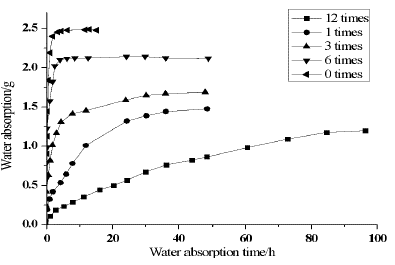
Figure 3 One-dimensional water absorption characteristic curve of samples after different dry-wet cycles
Uniaxial compressive strength of complete and single crack specimens under different dry-wet cycles
The following table shows the uniaxial compressive strength of complete specimens and single crack specimens under different wet and dry cycles. It can be seen from the table that the crack dip will affect the uniaxial compressive strength. The relationship between crack inclination and uniaxial compressive strength under different wet-dry cycles is shown in the following figure. It can be seen from the figure that the number of dry-wet cycles and the inclination of cracks will affect the uniaxial compressive strength. The uniaxial compressive strength of single fracture specimen increases with the increase of crack inclination regardless of the number of dry-wet cycles. Under the same fracture inclination, the uniaxial compressive strength of single fracture specimen decreases with the increase of the number of dry-wet cycles. With the same number of wet and dry cycles, the uniaxial compressive strength of single fracture specimen increases with the increase of fracture inclination. The uniaxial compressive strength of a single fracture specimen is the lowest when the fracture dip is equal to 30 degrees. After that, the uniaxial compressive strength of the single fracture specimen increases with the increase of the crack inclination.
Conclusion
In this study, gypsum rock is taken as the research object for the deterioration of gypsum rock under the action of dry-wet cycle. In order to study the deterioration of the physical and mechanical properties of gypsum rocks caused by dry-wet cycling, combined with laboratory tests, theoretical analysis and numerical simulation of particle flow, gypsum rocks under different dry-wet cycles are tested for water absorption and water loss, and finally the water absorption and water loss characteristics, pore characteristics and mechanical characteristics of gypsum rocks are obtained. The deterioration effect of gypsum rock under dry-wet cycling is discussed in detail. Experiments show that during the dry-wet cycle, the hydrophysical and hydrochemical processes promote each other, which changes the crystal structure and pore structure of gypsum rocks, reduces the crystal strength and increases the porosity, thus leading to the deterioration of the mechanical properties of gypsum rocks.
Table 4 Uniaxial compressive strength of complete and single crack specimens under different dry-wet cycles
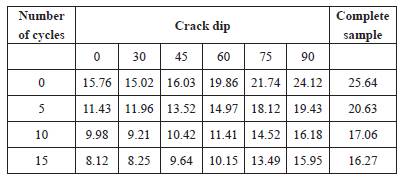
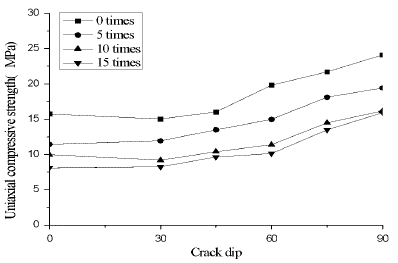
Figure 4 The relationship between uniaxial compressive strength and crack inclination of single fracture specimen under different wet-dry cycles
Due to the limited ability and time, there are still many deficiencies in the research content of this study. At present, the dry-wet cyclic deterioration tests are often aimed at intact rocks, without considering the influence of cracks on the deterioration of rock mechanical properties. In this study, the deterioration characteristics of single-fissure gypsum rocks under dry-wet cycling are preliminarily studied by means of the particle low model of gypsum rocks. The results show that the occurrence of cracks has changed the deterioration law of rocks and has obvious influence. In practical engineering, more fractured rock mass is involved. The deterioration characteristics of fractured rock mass must be different from that of intact rock mass. Therefore, in the future research, the deterioration mechanism of fractured rock mass under dry-wet cycling can be further studied.













